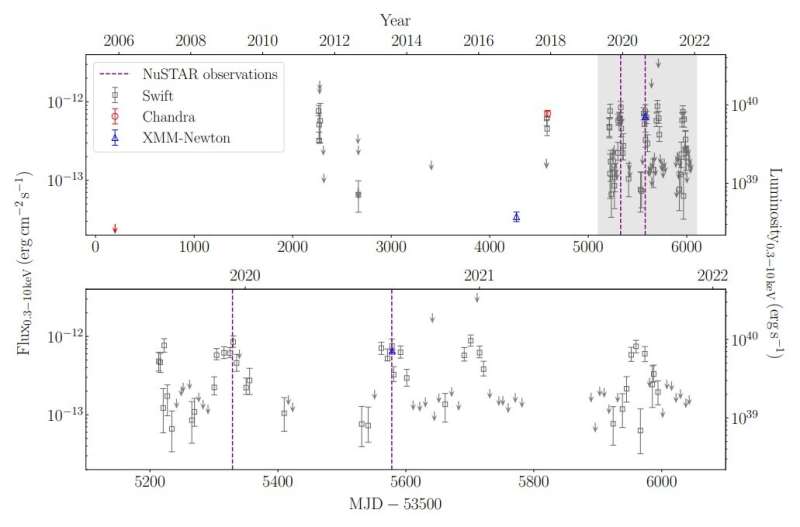June 28, 2022 report
Research investigates variability of the ultraluminous X-ray source NGC 925 ULX-3

Astronomers from the California Institute of Technology (Caltech) and elsewhere have observed an ultraluminous X-ray source known as NGC 925 ULX-3 using NASA's Swift and NuSTAR spacecraft, as well as ESA's XMM-Newton satellite. Results of this observational campaign, published June 16 on arXiv.org, deliver important insights into variability behavior of this source.
Ultraluminous X-ray sources (ULXs) are point sources in the sky that are so bright in X-rays that each emits more radiation than 1 million suns emit at all wavelengths. They are less luminous than active galactic nuclei, but more consistently luminous than any known stellar process. Although numerous studies of ULXs have been conducted, the basic nature of these sources remains unsolved.
NGC 925 ULX-3 is a highly variable ultraluminous X-ray source serendipitously detected as during NASA's Chandra spacecraft observations of NGC 925—a spiral galaxy located some 31 million light years away. Although few observations of this ULX have been conducted, the nature of its variability is still poorly understood.
So a team of astronomers led by Caltech's Hannah P. Earnshaw carried out a monitoring campaign of ULX-3 using Swift, supplemented by target-of-opportunity observations with XMM-Newton and NuSTAR triggered when this source was bright.
"We report the results of a 2019–2021 monitoring campaign with Swift and associated target-of-opportunity observations with XMM-Newton and NuSTAR, examining the spectral and timing behavior of the highly variable ultraluminous X-ray source (ULX) NGC 925 ULX-3," the researchers wrote in the paper.
The study revealed that ULX-3 exhibits a 127–128-day periodicity over which it enters and leaves the ULX luminosity regime. This is likely a superorbital variation that is common in ULXs containing neutron star accretors. Moreover, the source showcases flux variation of around an order of magnitude, which is also typical for ULXs discovered so far.
However, while the luminosity of ULX-3 varies by approximately an order of magnitude in flux, there is no indication of a change in accretion state. Therefore, the authors of the paper assume that this source is a strong candidate for being a neutron star ULX. They added that the magnetic field of such a neutron star may be at a level of one trillion Gauss.
The observations found that ULX-3 experiences a dip in luminosity in the middle of an otherwise bright state. The phase-folded light curves suggest that this dip may recur at a similar phase of the cycle, and likely does not last longer than a few days. The astronomers noted that such dipping behavior has also been seen in other ULXs with long periods, and may be due to periodic or superperiodic obscuration of the source.
The study did not find any evidence of pulsations in ULX-3. The researchers hope that further observations of this source will change this as pulsations may be crucial in helping us better understand the properties of ULX-3.
More information: Hannah P. Earnshaw et al, The variability behavior of NGC 925 ULX-3. arXiv:2206.08397v1 [astro-ph.HE], arxiv.org/abs/2206.08397
© 2022 Science X Network





















